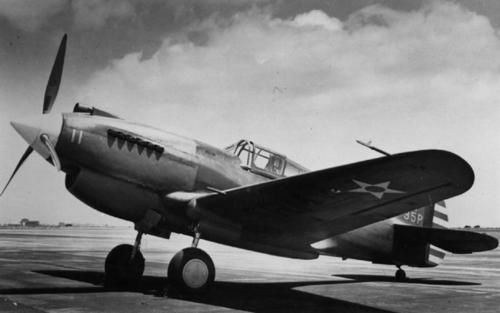![]()

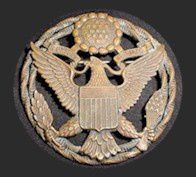

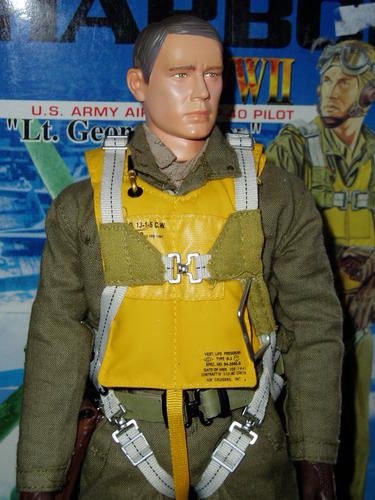
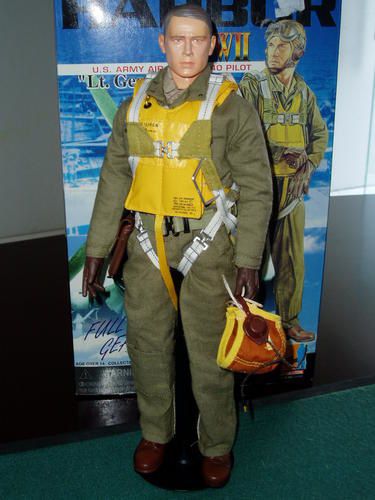
![]()
![]()


George S. Welch
Pearl Harbor Hero
Written by Raymond J. Castagnaro and Lyle F. Padilla for their History, Legend and Myth: Hollywood and the Medal of Honor website
Welch was assigned to the 47th Fighter Squadron, 18th Fighter Group flying P-40 Kittyhawks at Wheeler Field, near Pearl Harbor, Hawaii in 1941. A fellow fighter pilot of the 18th Group, Francis S. Gabreski (who would later go on to become the top American Ace in the European Theater in World War II) described him.
"He was a rich kid, heir to the grape juice family, and we couldn't figure out why he was there since he probably could have avoided military service altogether if he wanted to." Many Japanese military aviators would regret that he hadn't.
In the beginning of December, 1941, Welch and 2nd Lt. Kenneth Taylor had moved their P-40s away from the main airfield at Wheeler to a nearby auxiliary field at Haleiwa as part of a gunnery exercise. The vast majority of Army Air Force fighters at Wheeler were parked in neat rows on the main flightline; although war with Japan appeared imminent, it was decided that the possibility of sabotage from the ground presented a greater threat than a potential air attack, and it was easier to guard them while parked in neat rows than dispersed on the airfield perimeter. Thus when the Japanese carrier-based sneak attack against Pearl Harbor and Wheeler and Hickam Fields came on the morning of December 7, 1941, the majority of the Army Air Force fighter force was easily destroyed on the ground, several of them when the first P-40 pilot attempting to take off to fight was hit and killed on his takeoff roll and his fighter went crashing down the flightline at Wheeler.
That Sunday morning Welch and Taylor were just leaving an all-night party at Wheeler Field, Hawaii. As they stood outside an army barracks watching the tropical dawn grow brighter, neither had any idea of the momentous event which was about to change their - lives. Welch was saying that instead of going to sleep, he wanted to drive back to their own base at nearby Haleiwa Field for a nice Sunday morning swim.
Suddenly the Japanese swooped down on Wheeler Field, which was a center for fighter operations in Hawaii. Dive bombers seemed to appear out of nowhere. Violent explosions upended the parked planes, and buildings began to burn. Welch ran for a telephone and called Haleiwa as bullets sprayed around him.
"Get two P-40s ready!" he yelled. "It's not a gag--the Japs are here."
The drive up to Haleiwa was a wild one. Japanese Zeros strafed Welch and Taylor three times. When the two fliers careened onto their field nine minutes later, their fighter planes were already armed and the propellers were turning over. Without waiting for orders they took off.
As they climbed for altitude they ran into twelve Japanese Val dive bombers over the Marine air base at Ewa. Welch and Taylor began their attack immediately. on their first pass, machine guns blazing, each shot down a bomber. As Taylor zoomed up and over in his Tomahawk, he saw an enemy bomber heading out to sea. He gave his P-40 full throttle and roared after it. Again his aim was good and the Val broke up before his eyes. In the meantime Welch's plane had been hit and he dived into a protective cloud bank. The damage didn't seem too serious so he flew out again--only to find himself on the tail of another Val. With only one gun now working he nevertheless managed to send the bomber flaming into the sea.
Both pilots now vectored toward burning Wheeler Field for more ammunition and gas. Unfortunately the extra cartridge belts for the P-40s were in a hangar which was on fire. Two mechanics ran bravely into the dangerous inferno and returned with the ammunition.
The Japanese were just beginning a second strafing of the field as Welch and Taylor hauled their P-40s into the air again. They headed directly into the enemy planes, all guns firing. This time Ken Taylor was hit in the arm, and then a Val closed in behind him. Welch kicked his rudder and the Tomahawk whipped around and blasted the Val, though his own plane had been hit once more. Taylor had to land, but George Welch shot down still another bomber near Ewa before he returned.
Perhaps twenty American fighter planes managed to get into the air that morning--including five obsolete Republic P-35s. Most of them were shot down, but their bravery and initiative accounted for six victories in the one-sided aerial battle
Welch was nominated for the Medal of Honor for his actions on Pearl Harbor Day, and the Air Force Chief, General Henry H. Arnold was reportedly anxious to receive the nomination. Unfortunately for Welch, the intermediate chain of command, their pride evidently smarting from having been caught off guard and suffering the devastation they did, reasoned absurdly that Welch had taken off without proper authorization and could therefore not be awarded the Nation's highest military award; the award was downgraded to a Distinguished Service Cross.
Welch remained in the Pacific Theater of Operations and went on to score 12 more kills against Japanese aircraft (16 in total). After the war, he became the chief test pilot for North American Aviation, makers of a long line of successful fighters that began with the P-51 Mustang, generally recognized as the best fighter of any air force in World War II. Welch began testing the prototype P-86 (later redesignated F-86) Sabre, a new jet fighter which combined the aerodynamic advances of the propeller-driven Mustang with the lessons of swept-wing research the Germans had developed for their jet aircraft toward the end of the war.
![]()

![]()
Pearl Harbor.Hawai .Sunday .December.7/1941
Sequence of Events
Saturday, December 6 - Washington D.C. - U.S. President Franklin Roosevelt makes a final appeal to the Emperor of Japan for peace. There is no reply. Late this same day, the U.S. code-breaking service begins intercepting a 14-part Japanese message and deciphers the first 13 parts, passing them on to the President and Secretary of State. The Americans believe a Japanese attack is imminent, most likely somewhere in Southeast Asia.
Sunday, December 7 - Washington D.C. - The last part of the Japanese message, stating that diplomatic relations with the U.S. are to be broken off, reaches Washington in the morning and is decoded at approximately 9 a.m. About an hour later, another Japanese message is intercepted. It instructs the Japanese embassy to deliver the main message to the Americans at 1 p.m. The Americans realize this time corresponds with early morning time in Pearl Harbor, which is several hours behind.
The U.S. War Department then sends out an alert but uses a commercial telegraph because radio contact with Hawaii is temporarily broken. Delays prevent the alert from arriving at headquarters in Oahu until noontime (Hawaii time) four hours after the attack has already begun.
Sunday, December 7 - Islands of Hawaii, near Oahu - The Japanese attack force under the command of Admiral Nagumo, consisting of six carriers with 423 planes, is about to attack. At 6 a.m., the first attack wave of 183 Japanese planes takes off from the carriers located 230 miles north of Oahu and heads for the U.S. Pacific Fleet at Pearl Harbor.
Pearl Harbor - At 7:02 a.m., two Army operators at Oahu's northern shore radar station detect the Japanese air attack approaching and contact a junior officer who disregards their reports, thinking they are American B-17 planes which are expected in from the U.S. west coast.
Near Oahu - At 7:15 a.m., a second attack wave of 167 planes takes off from the Japanese carriers and heads for Pearl Harbor.
Pearl Harbor is not on a state on high alert. Senior commanders have concluded, based on available intelligence, there is no reason to believe an attack is imminent. Aircraft are therefore left parked wingtip to wingtip on airfields, anti-aircraft guns are unmanned with many ammunition boxes kept locked in accordance with peacetime regulations. There are also no torpedo nets protecting the fleet anchorage. And since it is Sunday morning, many officers and crewmen are leisurely ashore.
At 7:53 a.m., the first Japanese assault wave, with 51 'Val' dive bombers, 40 'Kate' torpedo bombers, 50 high level bombers and 43 'Zero' fighters, commences the attack with flight commander, Mitsuo Fuchida, sounding the battle cry: "Tora! Tora! Tora!" (Tiger! Tiger! Tiger!).
The Americans are taken completely by surprise. The first attack wave targets airfields and battleships. The second wave targets other ships and shipyard facilities. The air raid lasts until 9:45 a.m. Eight battleships are damaged, with five sunk. Three light cruisers, three destroyers and three smaller vessels are lost along with 188 aircraft. The Japanese lose 27 planes and five midget submarines which attempted to penetrate the inner harbor and launch torpedoes.
Escaping damage from the attack are the prime targets, the three U.S. Pacific Fleet aircraft carriers, Lexington, Enterprise and Saratoga, which were not in the port. Also escaping damage are the base fuel tanks.
The casualty list includes 2,335 servicemen and 68 civilians killed, with 1,178 wounded. Included are 1,104 men aboard the Battleship USS Arizona killed after a 1,760-pound air bomb penetrated into the forward magazine causing catastrophic explosions.
In Washington, various delays prevent the Japanese diplomats from presenting their war message to Secretary of State, Cordell Hull, until 2:30 p.m. (Washington time) just as the first reports of the air raid at Pearl Harbor are being read by Hull.
News of the "sneak attack" is broadcast to the American public via radio bulletins, with many popular Sunday afternoon entertainment programs being interrupted. The news sends a shockwave across the nation and results in a tremendous influx of young volunteers into the U.S. armed forces. The attack also unites the nation behind the President and effectively ends isolationist sentiment in the country.
Monday, December 8 - The United States and Britain declare war on Japan with President Roosevelt calling December 7, "a date which will live in infamy..."
Thursday, December 11 - Germany and Italy declare war on the United States. The European and Southeast Asian wars have now become a global conflict with the Axis powers; Japan, Germany and Italy, united against America, Britain, France, and their Allies.
Wednesday, December 17 - Admiral Chester W. Nimitz becomes the new commander of the U.S. Pacific Fleet.
Both senior commanders at Pearl Harbor; Navy Admiral Husband E. Kimmel, and Army Lt. General Walter C. Short, were relieved of their duties following the attack. Subsequent investigations will fault the men for failing to adopt adequate defense measures.

![]()
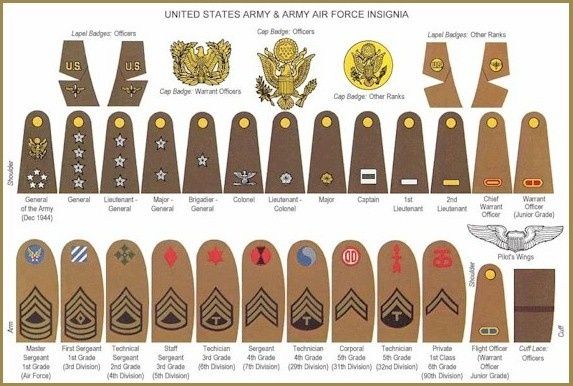
The Curtiss P-40
Was the last successful fighter aircraft produced by the once-dominant Curtiss Company. It was a competent but never great fighter, not one of the best fighters of the Second World War, but good enough to remain in use through the war, and production until the end of 1944. Only the P-51 Mustang and P-47 Thunderbolt were produced in greater numbers. The biggest advantage possessed by the P-40 was that it was available at least a year earlier than the P-47.
In every theatre it appeared in, the P-40 was outclassed in some way by its opponents, either in speed, performance or altitude or manoeuvrability. However, it was always survivable, making it a good ground attack aircraft. It was also one of the faster aircraft in a dive, and was fast at low altitude. Successive versions of the aircraft improved enough to make sure it never became obsolete, but never quite enough to make it great. However, it is often unfairly compared to aircraft that first entered service one or two years after the P-40, such as the P-47, which entered service in 1942, or the P-51 Mustang, which did not appear in its world beating Rolls Royce powered version until early 1943. The P-40 Warhawk had the massive advantage of actually being available when it was needed.
Naming the Hawk
The Curtiss Hawk series of fighters suffers from one of the more confusing naming systems of any aircraft in use in the Second World War. The aircraft had been developed from the earlier P-36/ Hawk 75. Intermediate aircraft included the Hawk 75-I/ XP-37, given an entirely new designation by the Army Air Corp, but not by Curtiss. The P-40 itself was given two designations by Curtis – Hawk 81 and Hawk 87. The British followed Curtiss, calling the Hawk 81 the Tomahawk and the Hawk 87 the Kittyhawk. Later the USAAF adopted the name Warhawk, which was then adopted by the British to avoid confusion. The Hawk 87/ Kittyhawk also appeared in two overlapping families, using different engines.
Variants
P-40 (P-40-CU)
The first 199 aircraft produced were simply designated P-40s. They carried two .50 calibre machine guns in the engine cowling, and one .30 calibre machine gun in each wing. The engine was an Allison V-1710-33, producing 1,090 hp. During the production run a second .30 calibre machine gun was added to each wing, giving the P-40 six guns. The production aircraft had a top speed of 357 mph at 15,000 feet, commendably close to that produced by the prototype. 200 of the initial order of 524 were produced before the order was deferred to allow Curtis to build 142 Hawk 81s for the French. This aircraft did not arrive in time for the battle of France, and were instead delivered to Britain, where they were known as Tomahawks.
P-40B
When USAAF production resumed after the French order, the designation was altered to P-40B. This version adopted pilot armour, a bullet proof windscreen and self-sealing fuel tanks. These changes had to be made on just about every American aircraft in production at the time. The P-40B (Hawk H-81 A-2) could also carry bombs under each wing. The USAAF received 131 P-40Bs. Production of the P-40B began in January 1941, and ended in April of the same year.
P-40C
The P-40C was the final Hawk 81 model (H-81 A-3). The main change was the addition of an extra fuel tank, capable of carrying 134 gallons. The P-40, P-40B and P-40C were known in RAF service as the Tomahawk, and also equipped the famous Flying Tigers in China. 193 P-40Cs were built for the USAAF, and were delivered between March and April 1941.
P-40D
The P-40D saw a series of major changes to the aircraft. It used the Allison V-1710-39 engine, which offered more power at higher altitudes than the earlier engines. The two .50 calibre machine guns from the nose were moved to the wings, with the four .30 calibre guns. The type could also carry two 20mm cannon. The most obvious visual change saw the radiators moved forward, giving the aircraft its familiar “shark mouth” appearance. The amount of ammunition carried was increased to 615 rounds per gun. The P-40D could carry one 500lb bomb under the fuselage. Both Curtis and the RAF acknowledged the importance of these changes with a change of designation – Curtis to Hawk 87A, and the RAF to Kittyhawk. However, only 42 P-40Ds were built, 22 for the USAAF and 20 for the RAF.
P-40E
The main change made for the P-40E (Hawk 87A-3) was the replacement of all of the .30 calibre guns with .50 calibre machine guns. This gave the P-40E a total of six .50 calibre machine guns. Eight hundred and twenty of this model were produced for the USAAF.
P-40E-1
This refers to 1,500 P-40Es produced to be supplies to the British under lend-lease. This type served with a variety of Commonwealth air forces as the Kittyhawk IA.
P-40F
The P-40F (H-87D) saw a major change of engine, to the Packard Merlin XX. Otherwise the P-40F was very similar to the P-40E. During the production run the fuselage was made two feet longer, improving directional stability. In RAF service this was known as the Kittyhawk II. The Merlin engine gave the P-40 much better high altitude performance – the Allison engine lost power above 15,000 feet, the Merlin kept going to 19,000 feet.
P-40K
The P-40K was developed from the P-40E. The main change was the use of the Allison V-1710-73 engine. The extra power this gave caused the same problems as had been faced in the P-40F. The first reaction was to increase the size of the dorsal fin, but later in the production run the longer fuselage used in the P-40F was adopted. The USAAF took delivery of 1,300 P-40Ks. The RAF received 21 of these aircraft as Kittyhawk IIIs.
P-40L
This was a development of the earlier P-40F, retaining the Packard Merlin. A great deal of effort went into reducing the weight of the aircraft, and indeed 450 lbs was removed. Amongst the changes was the removal of one gun from each wing, giving the P-40L a total of four wing mounted guns. However, the hoped for increase in speed did not materialise – the P-40L was only 4 mph quicker than the P-40F. The RAF retained the Kittyhawk II designation for this version. Later production P-40Ls could carry rockets under the wings.
P-40M
The P-40M (Kittyhawk III) was intended for the RAF. It resembled the P-40K, with a Allison V-1710-81 engine and six .50 calibre machine guns.
P-40N
This version was produced in greater numbers than any other. 5,219 P-40Ns (Hawk H-87Ws) were built before production ended on 30 November 1944. It used the same Allison V-1710-81 engine as the P-40M. Like the P-40L, the number of guns was reduced to four, and other weight saving measures were taken. The result was a much improved top speed of 378 mph. During the production run the lost guns were replaced – in the fighter bomber role the added firepower mattered more than that last bit of speed.
XP-40Q
This was the final prototype P-40. It used a much more powerful Allison V-1710-121 engine, providing 1,425 hp. In tests it reached a top speed of 422 mph and 20,000ft, a great improvement on any earlier P-40. However, by that point in the war the Spitfire and Mustang offered much better performance, and the P-40Q was not developed any further.
| |
|---|
| The Curtiss P-40 served during most of the Second World War with one air force or another, and under several different names including Tomahawk and Kittyhawk in Britain and Warhawk in the United States. |
![]()

![]()
| Specifications: | |||
|---|---|---|---|
| Curtiss P-40 Warhawk | |||
| Dimensions: | |||
| P-40 Model H81 | P-40E Model H87-B2 | P-40L Model H87-B3 | |
| Wing span: | 37 ft 3-1/2 in (11.35 m) | 37 ft 3-1/2 in (11.35 m) | 37 ft 3-1/2 in (11.35 m) |
| Length: | 31 ft 8-1/2 in (9.65 m) | 31 ft 2 in (9.49 m) | 31 ft 2 in (9.49 m) |
| Height: | 10 ft 7 in (3.22 m) | 10 ft 7 in (3.22 m) | 10 ft 11 in (3.32 m) |
| Weights: | |||
| Empty: | 5,376 lb. (2,439 kg) | 6,350 lb. (2,880 kg) | 6,480 lb. (2,939 kg) |
| Gross: | 6,787 lb (3,079 kg) | 8,280 lb (3,756 kg) | 8,080 lb (3,665 kg) |
| Max T/O: | 7,215 lb (3,273 kg) | 9,200 lb (4,173 kg) | 8,900 lb (4,037 kg) |
| Performance: | |||
| Max Speed: | 357 mph (575 km/h) | 366 mph (589 km/h) | 370 mph (595 km/h) |
| Ceiling: | 32,750 ft. (9,982 m) | 29,000 ft. (8,839 m) | 36,000 ft. (10,973 m) |
| Range: | 950 miles (1,529 km) | 350 miles (563 km) | 300 miles (483 km) |
| Max Range: | 1,400 miles (2,253 km) | 950 miles (1,529 km) | 1,375 miles (2,213 km) |
| Powerplant: | ||
|---|---|---|
| P-40 | P-40E | P-40L |
| Allison V-1710-33 1,040 hp, supercharged, 12 cylinder V engine. | Packard Merlin V-1650-39 1,150 hp, 12 cyl. V engine. | Packard Merlin V-1650-1 1,300 hp, 12 cyl. V engine. |
| Armament: | ||
| Two .50 caliber machine guns, Two .30 caliber machine guns, external bomb load of 120 lbs. (54 kg.) | Six .50 caliber machine guns, external bomb load of 500 lbs. (227 kg.) | Four/Six .50 caliber machine guns, external bomb load of 700 lbs. (318 kg.) |
![]()
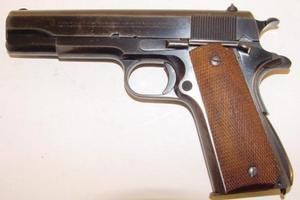
| M1911A1 |
| Action: Single |
| Caliber: .45 ACP |
| Capacity: 7 Rounds |
| Barrel Length: 125 mm |
| Weight: 1080 g |
| Overall Length: 216 mm |
![]()
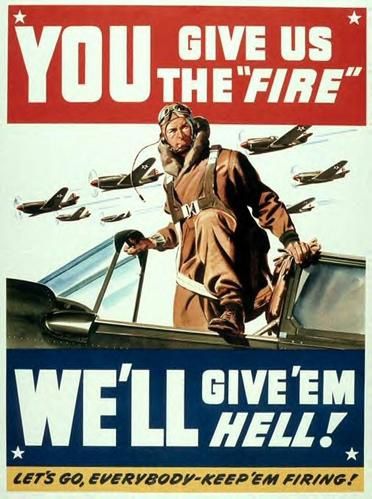
![]()
![]()





















/idata%2F0396584%2FKOREA%2F71910_korea_MIA1_800.JPG)
/idata%2F0396584%2FU.S.ARMY-POST-WW2%2Fphot4901a.jpg)
/idata%2F0396584%2FDRAWINGS-UNIFORMS-WW2%2F30-451-09b-2.jpg)
/idata%2F0396584%2FP-40%2F44FS000.jpg)
/idata%2F0396584%2FGERMAN-U-BOAT%2FBundesarchiv_Bild_101II-MW-1031-28-_Lorient-_U-31.jpg)
/idata%2F0396584%2FSOVIET-ARMY-WW2%2F1.jpg)



